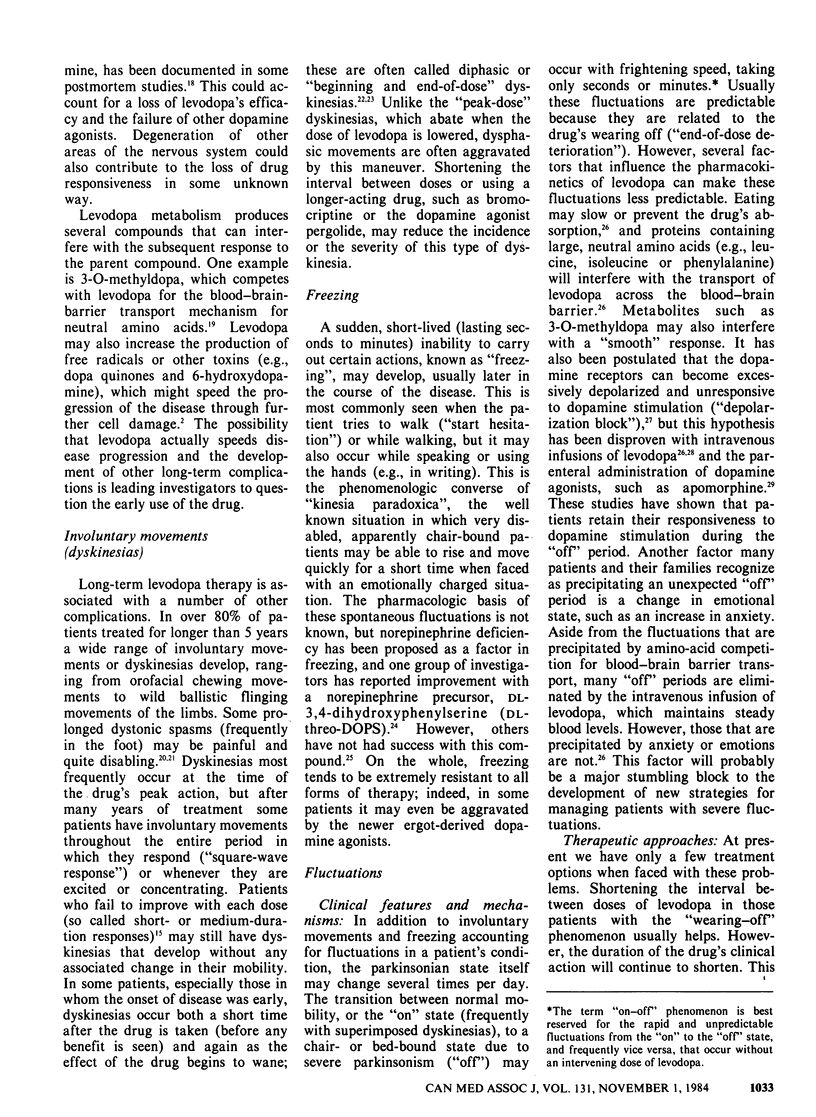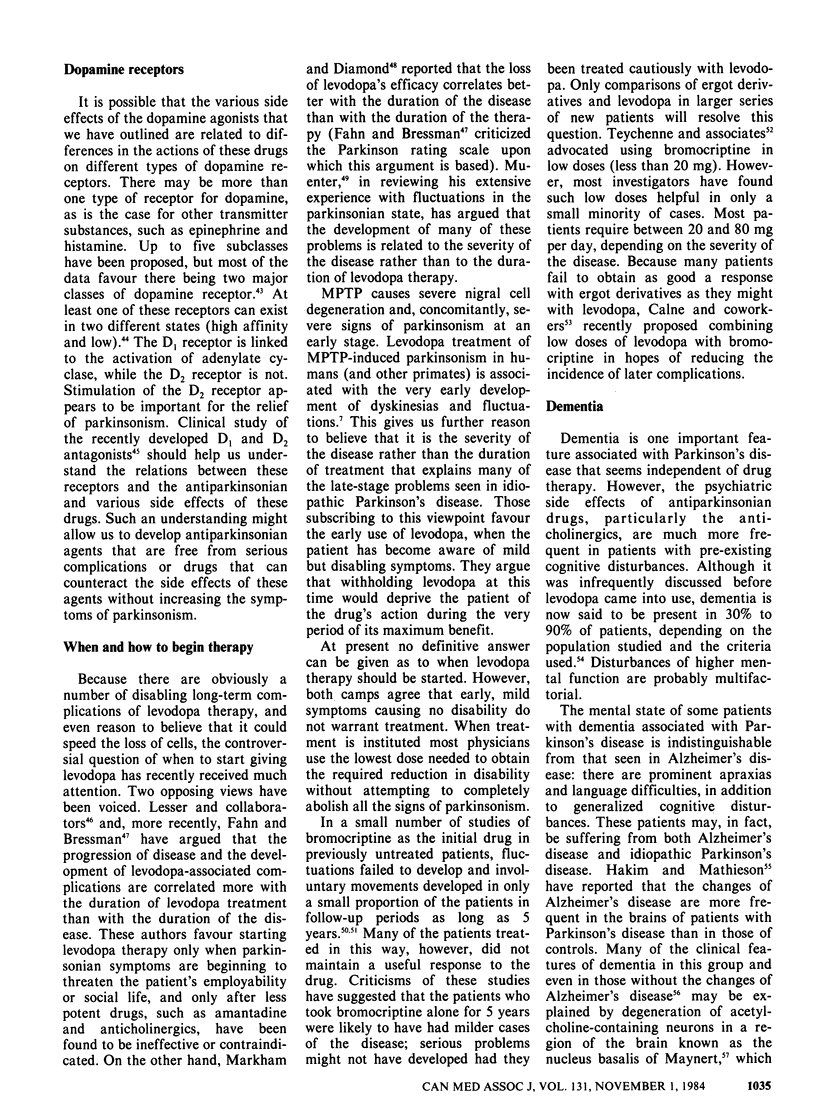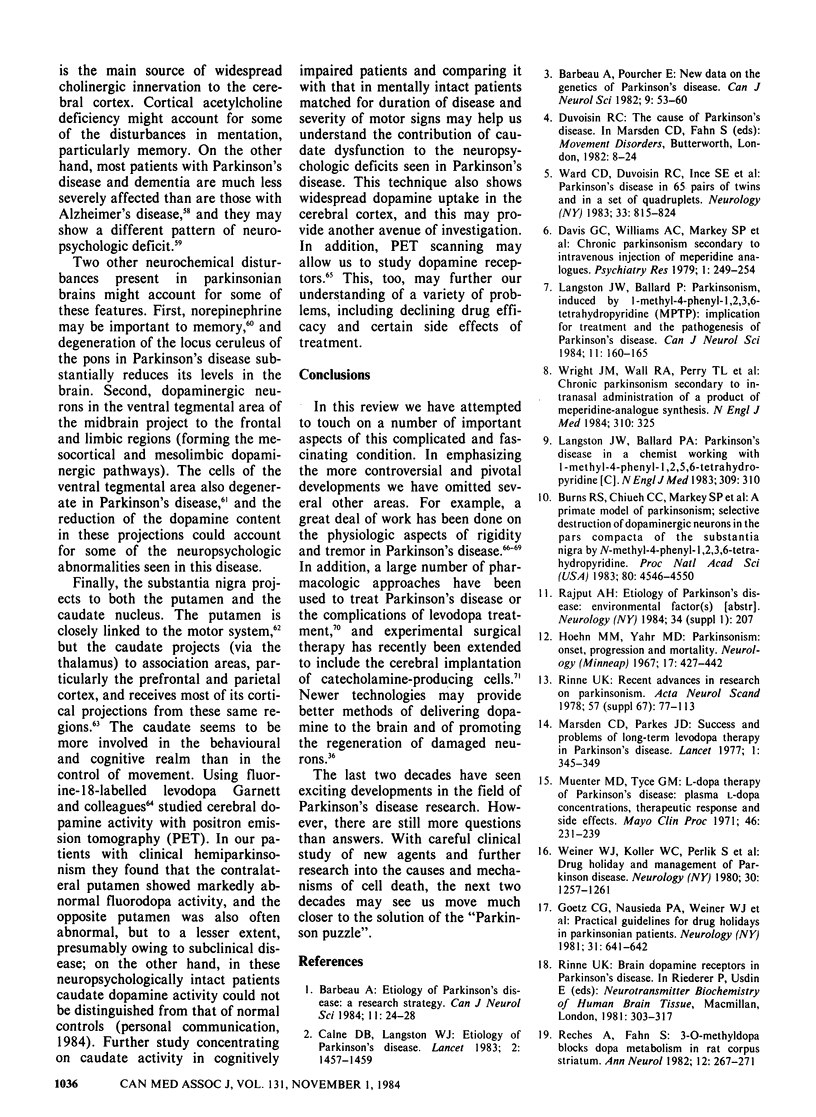Abstract
This update reviews several important topics in the field of Parkinson's disease, including etiologic studies, the types and mechanisms of drug complications and their treatment, when and how to begin treatment, the association of dementia with Parkinson's disease, and the development of the newer research tools. The recent discovery of a highly selective neurotoxin (MPTP) that causes parkinsonism in humans and other primates and the use of positron emission tomography in living patients should improve our understanding of the cause of cell death in Parkinson's disease and assist in the development of more definitive treatment for this common, disabling neurologic condition.
Full text
PDF






Selected References
These references are in PubMed. This may not be the complete list of references from this article.
- Barbeau A. Etiology of Parkinson's disease: A research strategy. Can J Neurol Sci. 1984 Feb;11(1):24–28. doi: 10.1017/s0317167100045273. [DOI] [PubMed] [Google Scholar]
- Barbeau A. Letter: Diphasic dyskinesia during levodopa therapy. Lancet. 1975 Mar 29;1(7909):756–756. doi: 10.1016/s0140-6736(75)91676-1. [DOI] [PubMed] [Google Scholar]
- Barbeau A., Pourcher E. New data on the genetics of Parkinson's disease. Can J Neurol Sci. 1982 Feb;9(1):53–60. doi: 10.1017/s031716710004364x. [DOI] [PubMed] [Google Scholar]
- Birkmayer W., Riederer P., Youdim M. B. (-)Deprenyl in the treatment of Parkinson's disease. Clin Neuropharmacol. 1982;5(2):195–230. doi: 10.1097/00002826-198205020-00004. [DOI] [PubMed] [Google Scholar]
- Burns R. S., Chiueh C. C., Markey S. P., Ebert M. H., Jacobowitz D. M., Kopin I. J. A primate model of parkinsonism: selective destruction of dopaminergic neurons in the pars compacta of the substantia nigra by N-methyl-4-phenyl-1,2,3,6-tetrahydropyridine. Proc Natl Acad Sci U S A. 1983 Jul;80(14):4546–4550. doi: 10.1073/pnas.80.14.4546. [DOI] [PMC free article] [PubMed] [Google Scholar]
- Calne D. B., Burton K., Beckman J., Martin W. R. Dopamine agonists in Parkinson's disease. Can J Neurol Sci. 1984 Feb;11(1 Suppl):221–224. doi: 10.1017/s0317167100046448. [DOI] [PubMed] [Google Scholar]
- Calne D. B., Langston J. W. Aetiology of Parkinson's disease. Lancet. 1983 Dec 24;2(8365-66):1457–1459. doi: 10.1016/s0140-6736(83)90802-4. [DOI] [PubMed] [Google Scholar]
- Crawley J. C., Smith T., Veall N., Zanelli G. D., Crow T. J., Owen F. Dopamine receptors displayed in living human brain with 77Br-p-bromospiperone. Lancet. 1983 Oct 22;2(8356):975–975. doi: 10.1016/s0140-6736(83)90497-x. [DOI] [PubMed] [Google Scholar]
- Davis G. C., Williams A. C., Markey S. P., Ebert M. H., Caine E. D., Reichert C. M., Kopin I. J. Chronic Parkinsonism secondary to intravenous injection of meperidine analogues. Psychiatry Res. 1979 Dec;1(3):249–254. doi: 10.1016/0165-1781(79)90006-4. [DOI] [PubMed] [Google Scholar]
- Fahn S. "On-off" phenomenon with levodopa therapy in Parkinsonism. Clinical and pharmacologic correlations and the effect of intramuscular pyridoxine. Neurology. 1974 May;24(5):431–441. doi: 10.1212/wnl.24.5.431. [DOI] [PubMed] [Google Scholar]
- Fahn S., Bressman S. B. Should levodopa therapy for Parkinsonism be started early or late? Evidence against early treatment. Can J Neurol Sci. 1984 Feb;11(1 Suppl):200–205. doi: 10.1017/s0317167100046412. [DOI] [PubMed] [Google Scholar]
- Findley L. J., Gresty M. A., Halmagyi G. M. Tremor, the cogwheel phenomenon and clonus in Parkinson's disease. J Neurol Neurosurg Psychiatry. 1981 Jun;44(6):534–546. doi: 10.1136/jnnp.44.6.534. [DOI] [PMC free article] [PubMed] [Google Scholar]
- Garnett E. S., Firnau G., Nahmias C. Dopamine visualized in the basal ganglia of living man. Nature. 1983 Sep 8;305(5930):137–138. doi: 10.1038/305137a0. [DOI] [PubMed] [Google Scholar]
- Goetz C. G., Nausieda P. A., Weiner W. J., Klawans H. L. Practical guidelines for drug holidays in parkinsonian patients. Neurology. 1981 May;31(5):641–642. doi: 10.1212/wnl.31.5.641-b. [DOI] [PubMed] [Google Scholar]
- Grigoriadis D., Seeman P. The dopamine/neuroleptic receptor. Can J Neurol Sci. 1984 Feb;11(1 Suppl):108–113. doi: 10.1017/s0317167100046242. [DOI] [PubMed] [Google Scholar]
- Hakim A. M., Mathieson G. Dementia in Parkinson disease: a neuropathologic study. Neurology. 1979 Sep;29(9 Pt 1):1209–1214. doi: 10.1212/wnl.29.9_part_1.1209. [DOI] [PubMed] [Google Scholar]
- Hoehn M. M., Yahr M. D. Parkinsonism: onset, progression and mortality. Neurology. 1967 May;17(5):427–442. doi: 10.1212/wnl.17.5.427. [DOI] [PubMed] [Google Scholar]
- Hunter K. R., Boakes A. J., Laurence D. R., Stern G. M. Monoamine oxidase inhibitors and L-dopa. Br Med J. 1970 Aug 15;3(5719):388–388. doi: 10.1136/bmj.3.5719.388. [DOI] [PMC free article] [PubMed] [Google Scholar]
- Javoy-Agid F., Agid Y. Is the mesocortical dopaminergic system involved in Parkinson disease? Neurology. 1980 Dec;30(12):1326–1330. doi: 10.1212/wnl.30.12.1326. [DOI] [PubMed] [Google Scholar]
- Johnson A. M., Loew D. M., Vigouret J. M. Stimulant properties of bromocriptine on central dopamine receptors in comparison to apomorphine, (+)-amphetamine and L-DOPA. Br J Pharmacol. 1976 Jan;56(1):59–68. doi: 10.1111/j.1476-5381.1976.tb06959.x. [DOI] [PMC free article] [PubMed] [Google Scholar]
- Kebabian J. W., Beaulieu M., Itoh Y. Pharmacological and biochemical evidence for the existence of two categories of dopamine receptor. Can J Neurol Sci. 1984 Feb;11(1 Suppl):114–117. doi: 10.1017/s0317167100046254. [DOI] [PubMed] [Google Scholar]
- Kebabian J. W., Calne D. B. Multiple receptors for dopamine. Nature. 1979 Jan 11;277(5692):93–96. doi: 10.1038/277093a0. [DOI] [PubMed] [Google Scholar]
- Künzle H. Bilateral projections from precentral motor cortex to the putamen and other parts of the basal ganglia. An autoradiographic study in Macaca fascicularis. Brain Res. 1975 May 2;88(2):195–209. doi: 10.1016/0006-8993(75)90384-4. [DOI] [PubMed] [Google Scholar]
- Lang A. E., Quinn N., Brincat S., Marsden C. D., Parkes J. D. Pergolide in late-stage Parkinson disease. Ann Neurol. 1982 Sep;12(3):243–247. doi: 10.1002/ana.410120305. [DOI] [PubMed] [Google Scholar]
- Lang A. E. Treatment of Parkinson's disease with agents other than levodopa and dopamine agonists: controversies and new approaches. Can J Neurol Sci. 1984 Feb;11(1 Suppl):210–220. doi: 10.1017/s0317167100046436. [DOI] [PubMed] [Google Scholar]
- Langston J. W., Ballard P. A., Jr Parkinson's disease in a chemist working with 1-methyl-4-phenyl-1,2,5,6-tetrahydropyridine. N Engl J Med. 1983 Aug 4;309(5):310–310. doi: 10.1056/nejm198308043090511. [DOI] [PubMed] [Google Scholar]
- Langston J. W., Ballard P. Parkinsonism induced by 1-methyl-4-phenyl-1,2,3,6-tetrahydropyridine (MPTP): implications for treatment and the pathogenesis of Parkinson's disease. Can J Neurol Sci. 1984 Feb;11(1 Suppl):160–165. doi: 10.1017/s0317167100046333. [DOI] [PubMed] [Google Scholar]
- Lees A. J., Shaw K. M., Kohout L. J., Stern G. M., Elsworth J. D., Sandler M., Youdim M. B. Deprenyl in Parkinson's disease. Lancet. 1977 Oct 15;2(8042):791–795. doi: 10.1016/s0140-6736(77)90725-5. [DOI] [PubMed] [Google Scholar]
- Lees A. J., Stern G. M. Sustained bromocriptine therapy in previously untreated patients with Parkinson's disease. J Neurol Neurosurg Psychiatry. 1981 Nov;44(11):1020–1023. doi: 10.1136/jnnp.44.11.1020. [DOI] [PMC free article] [PubMed] [Google Scholar]
- Lesser R. P., Fahn S., Snider S. R., Cote L. J., Isgreen W. P., Barrett R. E. Analysis of the clinical problems in parkinsonism and the complications of long-term levodopa therapy. Neurology. 1979 Sep;29(9 Pt 1):1253–1260. doi: 10.1212/wnl.29.9_part_1.1253. [DOI] [PubMed] [Google Scholar]
- Lieberman A., Goldstein M., Neophytides A., Kupersmith M., Leibowitz M., Zasorin N., Walker R., Kleinberg D. Lisuride in Parkinson disease: efficacy of lisuride compared to levodopa. Neurology. 1981 Aug;31(8):961–965. doi: 10.1212/wnl.31.8.961. [DOI] [PubMed] [Google Scholar]
- Markham C. H., Diamond S. G. Evidence to support early levodopa therapy in Parkinson disease. Neurology. 1981 Feb;31(2):125–131. doi: 10.1212/wnl.31.2.125. [DOI] [PubMed] [Google Scholar]
- Marsden C. D., Parkes J. D. Success and problems of long-term levodopa therapy in Parkinson's disease. Lancet. 1977 Feb 12;1(8007):345–349. doi: 10.1016/s0140-6736(77)91146-1. [DOI] [PubMed] [Google Scholar]
- Mayeux R., Stern Y., Rosen J., Benson F. Is "subcortical dementia" a recognizable clinical entity? Ann Neurol. 1983 Sep;14(3):278–283. doi: 10.1002/ana.410140305. [DOI] [PubMed] [Google Scholar]
- McEntee W. J., Mair R. G. Memory impairment in Korsakoff's psychosis: a correlation with brain noradrenergic activity. Science. 1978 Nov 24;202(4370):905–907. doi: 10.1126/science.715450. [DOI] [PubMed] [Google Scholar]
- Melamed E. Early-morning dystonia. A late side effect of long-term levodopa therapy in Parkinson's disease. Arch Neurol. 1979 May;36(5):308–310. doi: 10.1001/archneur.1979.00500410086014. [DOI] [PubMed] [Google Scholar]
- Moskovitz C., Moses H., 3rd, Klawans H. L. Levodopa-induced psychosis: a kindling phenomenon. Am J Psychiatry. 1978 Jun;135(6):669–675. doi: 10.1176/ajp.135.6.669. [DOI] [PubMed] [Google Scholar]
- Muenter M. D., Sharpless N. S., Tyce G. M., Darley F. L. Patterns of dystonia ("I-D-I" and "D-I-D-") in response to l-dopa therapy for Parkinson's disease. Mayo Clin Proc. 1977 Mar;52(3):163–174. [PubMed] [Google Scholar]
- Muenter M. D. Should levodopa therapy be started early or late? Can J Neurol Sci. 1984 Feb;11(1 Suppl):195–199. doi: 10.1017/s0317167100046400. [DOI] [PubMed] [Google Scholar]
- Muenter M. D., Tyce G. M. L-dopa therapy of Parkinson's disease: plasma L-dopa concentration, therapeutic response, and side effects. Mayo Clin Proc. 1971 Apr;46(4):231–239. [PubMed] [Google Scholar]
- Nakano I., Hirano A. Parkinson's disease: neuron loss in the nucleus basalis without concomitant Alzheimer's disease. Ann Neurol. 1984 May;15(5):415–418. doi: 10.1002/ana.410150503. [DOI] [PubMed] [Google Scholar]
- Nutt J. G., Woodward W. R., Hammerstad J. P., Carter J. H., Anderson J. L. The "on-off" phenomenon in Parkinson's disease. Relation to levodopa absorption and transport. N Engl J Med. 1984 Feb 23;310(8):483–488. doi: 10.1056/NEJM198402233100802. [DOI] [PubMed] [Google Scholar]
- Parkes J. D., Schachter M., Marsden C. D., Smith B., Wilson A. Lisuride in parkinsonism. Ann Neurol. 1981 Jan;9(1):48–52. doi: 10.1002/ana.410090109. [DOI] [PubMed] [Google Scholar]
- Perlow M. J., Freed W. J., Hoffer B. J., Seiger A., Olson L., Wyatt R. J. Brain grafts reduce motor abnormalities produced by destruction of nigrostriatal dopamine system. Science. 1979 May 11;204(4393):643–647. doi: 10.1126/science.571147. [DOI] [PubMed] [Google Scholar]
- Quinn N., Marsden C. D., Parkes J. D. Complicated response fluctuations in Parkinson's disease: response to intravenous infusion of levodopa. Lancet. 1982 Aug 21;2(8295):412–415. doi: 10.1016/s0140-6736(82)90442-1. [DOI] [PubMed] [Google Scholar]
- Rascol A., Montastruc J. L., Guiraud-Chaumeil B., Clanet M. La bromocriptine comme premier traitement de la maladie de Parkinson. Résultats à long terme. Rev Neurol (Paris) 1982;138(5):401–408. [PubMed] [Google Scholar]
- Reches A., Fahn S. 3-O-methyldopa blocks dopa metabolism in rat corpus striatum. Ann Neurol. 1982 Sep;12(3):267–271. doi: 10.1002/ana.410120310. [DOI] [PubMed] [Google Scholar]
- Rinne U. K. Recent advances in research on Parkinsonism. Acta Neurol Scand Suppl. 1978;67:77–113. [PubMed] [Google Scholar]
- Rothwell J. C., Obeso J. A., Traub M. M., Marsden C. D. The behaviour of the long-latency stretch reflex in patients with Parkinson's disease. J Neurol Neurosurg Psychiatry. 1983 Jan;46(1):35–44. doi: 10.1136/jnnp.46.1.35. [DOI] [PMC free article] [PubMed] [Google Scholar]
- Schachter M., Marsden C. D., Parkes J. D., Jenner P., Testa B. Deprenyl in the management of response fluctuations in patients with Parkinson's disease on levodopa. J Neurol Neurosurg Psychiatry. 1980 Nov;43(11):1016–1021. doi: 10.1136/jnnp.43.11.1016. [DOI] [PMC free article] [PubMed] [Google Scholar]
- Tatton W. G., Bedingham W., Verrier M. C., Blair R. D. Characteristic alterations in responses to imposed wrist displacements in parkinsonian rigidity and dystonia musculorum deformans. Can J Neurol Sci. 1984 May;11(2):281–287. doi: 10.1017/s0317167100045546. [DOI] [PubMed] [Google Scholar]
- Tatton W. G., Lee R. G. Evidence for abnormal long-loop reflexes in rigid Parkinsonian patients. Brain Res. 1975 Dec 26;100(3):671–676. doi: 10.1016/0006-8993(75)90167-5. [DOI] [PubMed] [Google Scholar]
- Teychenne P. F., Bergsrud D., Racy A., Elton R. L., Vern B. Bromocriptine: low-dose therapy in Parkinson disease. Neurology. 1982 Jun;32(6):577–583. doi: 10.1212/wnl.32.6.577. [DOI] [PubMed] [Google Scholar]
- Ward C. D., Duvoisin R. C., Ince S. E., Nutt J. D., Eldridge R., Calne D. B. Parkinson's disease in 65 pairs of twins and in a set of quadruplets. Neurology. 1983 Jul;33(7):815–824. doi: 10.1212/wnl.33.7.815. [DOI] [PubMed] [Google Scholar]
- Weiner W. J., Koller W. C., Perlik S., Nausieda P. A., Klawans H. L. Drug holiday and management of Parkinson disease. Neurology. 1980 Dec;30(12):1257–1261. doi: 10.1212/wnl.30.12.1257. [DOI] [PubMed] [Google Scholar]
- Whitehouse P. J., Hedreen J. C., White C. L., 3rd, Price D. L. Basal forebrain neurons in the dementia of Parkinson disease. Ann Neurol. 1983 Mar;13(3):243–248. doi: 10.1002/ana.410130304. [DOI] [PubMed] [Google Scholar]
- Wright J. M., Wall R. A., Perry T. L., Paty D. W. Chronic parkinsonism secondary to intranasal administration of a product of meperidine-analogue synthesis. N Engl J Med. 1984 Feb 2;310(5):325–325. doi: 10.1056/NEJM198402023100520. [DOI] [PubMed] [Google Scholar]


